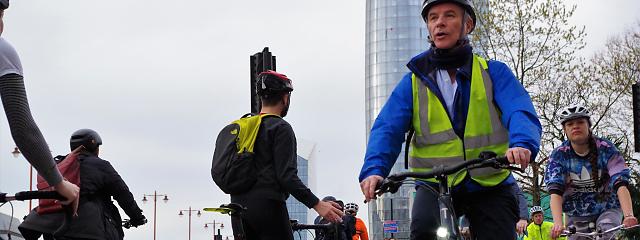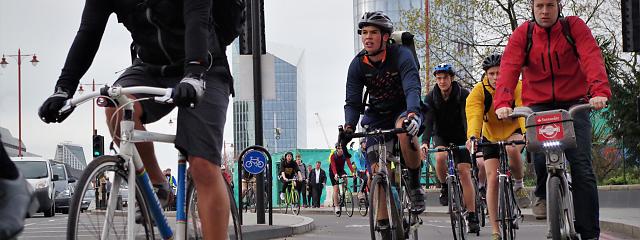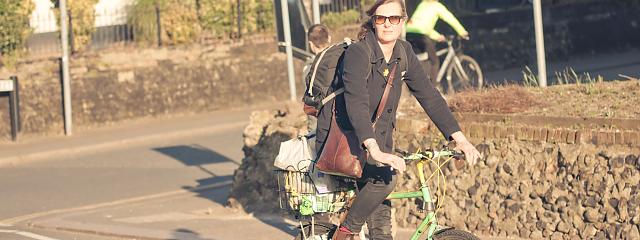
Getting more people cycling and walking by reducing car use
Getting more people cycling and walking by reducing car use
When I was a teenager, one of the local cycling clubs used to organise a series of rides at this time of year, all of them starting and finishing in Leigh, a town about nine miles west of Manchester.
The length of these reliability trials increased each week, with there and back rides to Chester, Whitchurch, Lancaster and finally Llangollen. Great memories, but seriously, I used to ride up and down the A6 from Preston to Lancaster for fun?
Back then all of those rides included long sections on A roads, but things were very different, and nothing brings home the increase in motor traffic and congestion more than looking at a road and remembering that you were happy cycling along it 30 years ago but wouldn’t consider doing so now.
The flaw in the law
Of course, in the intervening years we should have been reducing motor traffic, but instead we did the opposite, despite the Government recognising the problem and passing legislation designed to address it.
Just over twenty years ago laws were introduced through the Road Traffic Reduction Act 1997 and the Road Traffic Reductions (National Targets) Act 1998 requiring the Secretary of State to publish a report either setting targets to reduce road traffic in England, Wales and Scotland, or propose alternative targets or measures and explain why they were more appropriate, along with an impact assessment.
I know, people on bikes are traffic too, but for the purpose of the Road Traffic Reduction laws, traffic is defined as motor traffic, so bear with me.
As well as the obligation to report, the Secretary of State was also empowered to issue guidance to local authorities on road traffic reduction, and to require local authorities to issue reports setting out their own local targets for traffic reduction. It sounds sensible but sadly there was a flaw in the law, because it didn’t say how frequently the Secretary of State had to report.
20 years with our heads up our exhaust pipe
As the laws passed through parliament, a commitment was secured that a first report would be issued within 18 months, so the Secretary of State complied by issuing a report in 2000 called ’Tackling congestion and pollution’. In essence, it argued that there was no need to reduce road traffic, because it was sufficient to address the main side-effects of road traffic, namely congestion and pollution.
Congestion could be tackled with some well-targeted ‘pinch-point’ road improvements, while pollution could be tackled by working with the motor industry to promote cleaner vehicle technology.
And there’s never been another report, despite it becoming painfully obvious that ‘road improvements’ haven’t reduced congestion and that motor traffic has continued to be a major source of pollution, imposing significant human and financial costs on society. Twenty years later, it is all too clear that the approach set out in that report has failed, with catastrophic effects for our air quality and the wider environment, particularly our climate.
Politicians probably thought the car was king and feared the public reaction to measures to restrict car use, but perhaps they need to realise that opinions are changing.
Duncan Dollimore
The car is king
Politicians probably thought the car was king and feared the public reaction to measures to restrict car use, but perhaps they need to realise that opinions are changing. That’s clear from the latest National Travel Attitudes Survey, which shows clear support for using the car less, with 76% of people in England believing we need to drive less for the sake of the environment and to make our towns and cities better places to live.
Believing we should all do something is of course different to doing it, but 43% of people also said that they would be willing to reduce the amount they travel by car to reduce the impact of climate change. Perhaps no surprise then that in cities like Birmingham, Brighton and York, plans are being considered to ban or restrict car use to cut air pollution and reduce emissions.
Environment Bill
But whilst action in those cities is fantastic, the legislation passed in the late 90’s was designed to introduce both national and local targets for traffic reduction, and to ensure that progress was monitored. It failed, but next week we’re expecting the Government to put the Environment Bill before parliament, and as this is supposed to enshrine and protect environmental standards and principles, particularly around air quality, Cycling UK and others are hoping to persuade MPs to put forward amendments to correct the flaw in the traffic reduction laws.
Since they were passed we’ve had devolution, so rather than a Traffic Reduction Act report from the Secretary of State for the UK, we need one from each nation, and we’re suggesting the first should be within six months of the Environment Bill coming into effect, and thereafter at intervals of no longer than two years.
Spending on active travel to meet traffic reduction targets
In practice this would require each ‘appropriate national authority’ to consider the full range of policy measures that might reduce road traffic and its adverse impacts.That would include looking at the proportion of overall transport spending allocated to walking, cycling and public transport, something Cycling UK called for through our funding campaign and our recent election campaign when we asked prospective MPs to pledge to support increased investment in cycling and walking to at least 5% of overall transport spending this year, rising to at least 10% within five years.
It would also necessitate a review of land use planning, topical this week given the BBC’s report on how the UK’s housing is dominated by roads without accounting for the needs of pedestrians and cyclists.
Having considered those policy levers, national authorities would then be empowered to issue guidance to local traffic authorities on the preparation of, and consultation on, reports on road traffic in their areas. Local authorities would then be under a duty to report on compliance with their duties and take action to achieve the aims set out in the relevant national traffic reduction guidance.
Put simply, these amendments would require spending on active travel and related policy decisions that enabled traffic reduction targets to be met.
With a budget set for 11 March, requests for budget representations by 7 February and the Environment Bill expected next week, we’ve got lots to do in the coming weeks to make sure the Government starts committing to billions for cycling and walking not millions, so watch out for news about how you can help.











